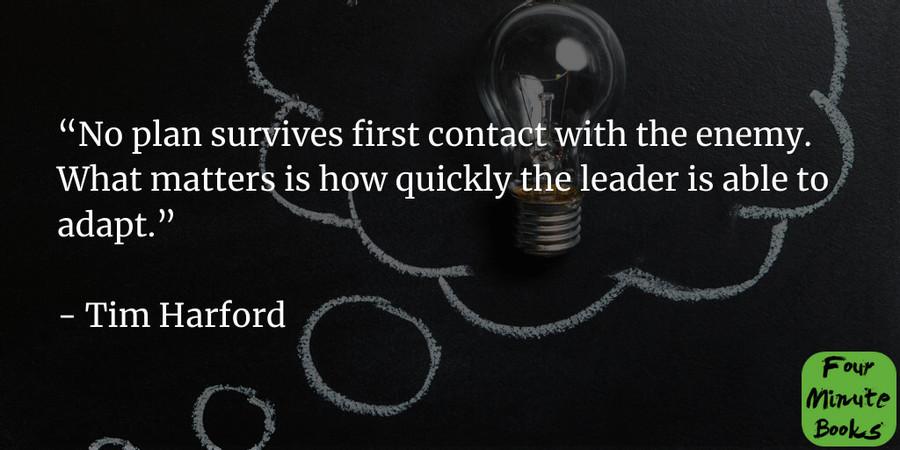Adapt Summary
Curated from: fourminutebooks.com
Ideas, facts & insights covering these topics:
19 ideas
·3.15K reads
22
1
Explore the World's Best Ideas
Join today and uncover 100+ curated journeys from 50+ topics. Unlock access to our mobile app with extensive features.
Adapt - Book Summary
Adapt proposes a surprising approach to accepting failure as a part of the innovation process.
21
352 reads
Author Quote
"No plan survives first contact with the enemy. What matters is how quickly the leader is able to adapt."
-Tim Hartford
27
427 reads
Book Overview
Growth implies an ongoing process of trial and error and gradual maturity. Whenever we face an opportunity, a challenge, or maybe just an experience that might turn into a life lesson, we are going to experience a few changes in our personality. And because we face all kinds of occurrences, we are constantly changing and growing.
20
261 reads
Using actual, legitimate examples, Adapt centers around the idea of accepting failure as a natural part of life, and more importantly, as an opportunity to grow and learn from it. Moreover, it is essential to understand that no one can predict the future and that we can only try to shape it with our current circumstances . We can do this by trying out different solutions to our problems. During this process, we will most likely fail a few times. However, this should not disappoint us, but rather encourage us to carry on and try different approaches.
19
199 reads
Top 3 Book Lessons
- Most predictions are wrong and the only thing we can do is manage our expectations and reactions.
- Trial and error processes harness innovation, while centralized authorities stifle it.
- Presents and patents are some of the best ways to encourage innovation.
But what do these lessons really mean?
21
233 reads
Lesson 1: Expectation beats disappointment
A study conducted by economist Paul Ormerod states that the extinction rate of companies and species are quite similar over a time frame of 500 million years. Who could’ve predicted that?
In another experiment from the book, experts tried to forecast the future of different companies, events, or even states, and they rarely came true.
19
186 reads
Harford suggests that we should consider failure a natural part of any process or plan . And rather than being disappointed, you should just eliminate that variable from then on and try again. Moreover, you should expect to fail many times before you encounter a successful approach to your problem. By following this mentality, whenever failure happens, you won’t take it too bad.
20
141 reads
Lesson 2: Bureaucracy and authority hold back innovation
Most of the time, organizations and leaders feel like they have more control over a problem than they actually do. This feeling of false know-how combined with formal authority often empowers them. Therefore, they make utopic decisions under the impression of total control.
20
150 reads
The book points towards centralization and its capacity to hinder innovation . Given the example of a top-down organization, the author explains how high-level managers cannot make better decisions than local executives that are accustomed to the place and problem.
18
126 reads
Another example is the Gulf War in Iraq. A general on the battlefield suggested that the army won over some employees of Saddam Hussein, but the high-level American authorities ignored them. Faced with this issue, individuals defied orders and formed a successful collaboration between citizens and troops.
18
121 reads
These examples teach us that there are certain situations when the innovative instinct surpasses the rational one. To be innovative, you have to think outside the box, even though you may fail. This doesn’t mean that you should defy authorities, but rather experiment with your creativity outside your usual framework.
20
112 reads
Lesson 3: Gifting prizes or awards can boost innovation
Innovation relies heavily on creativity and critical thinking. Therefore, we have to find ways to harness the creative process, brainstorming, and reasoning skills . We’ve seen how organizations often fail to do so due to high levels of centralization and bureaucracy. Now, let’s see how to achieve the opposite!
19
111 reads
Hartford suggests that if you want to enhance innovation , there are two ways to do this. The first one is patenting. By giving monopoly over an idea to the one that came up with it, you encourage that person and the people around them to be more innovative. Why? Because through a patent they can benefit personally from it.
20
99 reads
Another way to stimulate innovation is by awarding goal-oriented prizes . Not only will they be a source of praise for the researchers and their results, but they will also enhance competition and the discovery of new findings. Usually, the most effective innovation boosters are money prizes, research-specific awards, or titles.
20
98 reads
Creativity lays the foundation for development. The world we currently live in is the result of many creative processes and innovations. Therefore, we have to harness, nurture and protect all processes that have the potential to become discoveries, as they are the engine that drives our world towards better things.
19
94 reads
Adapt - B Review
Tim Harford introduces the reader to a series of surprising concepts, focusing specifically on the importance of accepting failure as part of our lives.
Adapt suggests that trial and error are necessary for any process and that without them people cannot discover the solutions they so desperately need in the world.
20
89 reads
He addresses some key matters humanity is finding hard to overcome, such as climate change, poverty , financial crisis, or innovative processes.
This book reveals essential lessons, suitable for any type of reader, as he confronts universal problems that we struggle with every day. The paper is a guide for thriving in our ever-changing world.
19
91 reads
Who would I recommend the Adapt Mto?
The 30-year old who wants to explore universal reads and learn about earthly concerns, the philosophy or psychology student who wants to gain a deeper understanding of their topics of interest, or anyone who wants to learn how to overcome failure.
19
100 reads
IDEAS CURATED BY
CURATOR'S NOTE
Adapt - Book Summary
“
Tom Joad's ideas are part of this journey:
Learn more about books with this collection
Strategies for building self-confidence
Techniques for embracing your strengths and accomplishments
Tips for seeking support and feedback
Related collections
Similar ideas
2 ideas
5 ideas
The Cultural Life Cycle of Organizations
psychologytoday.com
7 ideas
6 Ways To Approach Innovation
workitdaily.com
Read & Learn
20x Faster
without
deepstash
with
deepstash
with
deepstash
Personalized microlearning
—
100+ Learning Journeys
—
Access to 200,000+ ideas
—
Access to the mobile app
—
Unlimited idea saving
—
—
Unlimited history
—
—
Unlimited listening to ideas
—
—
Downloading & offline access
—
—
Supercharge your mind with one idea per day
Enter your email and spend 1 minute every day to learn something new.
I agree to receive email updates

